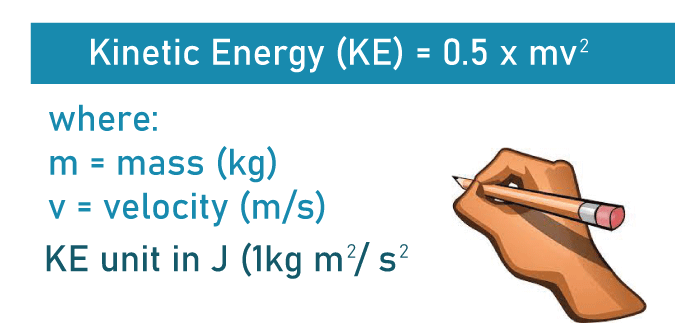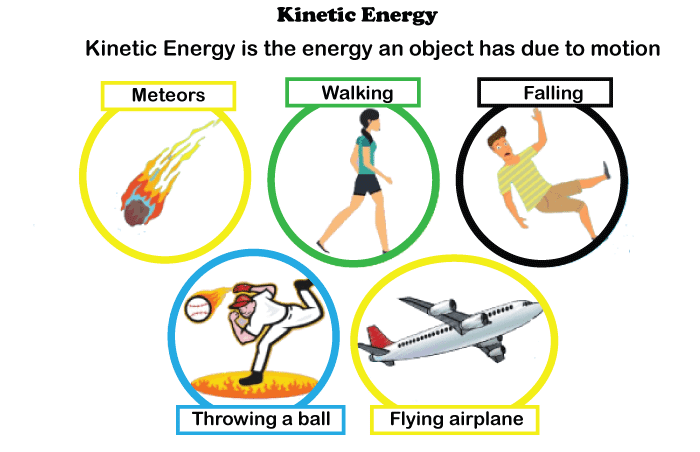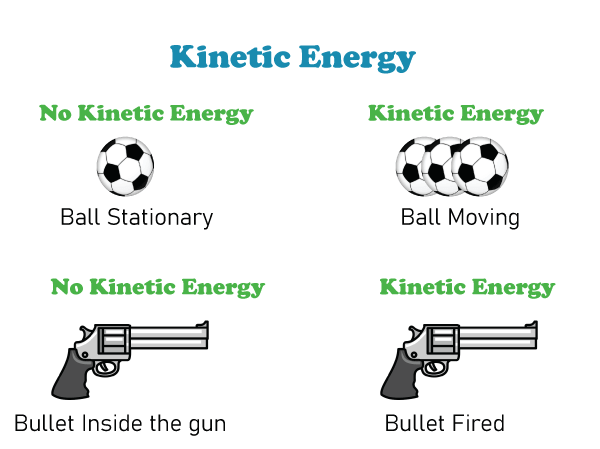Kinetic Energy DefinitionIntroductionAn object's energy due to its motion is called kinetic energy in physics. It is a key idea in physics because it is crucial to understanding how moving objects behave and interact in various contexts, from ordinary life to engineering and scientific inquiry. Kinetic energy is the quantity of energy that an object possesses as a result of its motion and may be computed using the formula: KE = 0.5mv^2 Where m is the object's mass, v is its velocity, and KE is its kinetic energy. According to this equation, an object's kinetic energy rises as its mass and velocity do. In other words, an object will have more kinetic energy the faster it goes. This contrasts vector values containing both magnitude and direction, such as velocity or acceleration. As kinetic energy can be transferred to other objects through collisions or interactions, it also measures the amount of work an object can accomplish in motion. 
Understanding the behavior of moving things is one of the most important uses of kinetic energy. For instance, we may utilize kinetic energy to forecast how two objects colliding at differing masses and speeds will behave. For example, we can apply kinetic energy to the collision of two objects with different masses and speeds. The system's total kinetic energy will be conserved if the two items collide elastically or without energy loss. This implies that the two objects' total kinetic energy before their collision will equal their total kinetic energies following it. Kinetic energy is utilized extensively in the study of thermodynamics. In this area, the movement of particles in a medium, such as a gas or a liquid, is called kinetic energy. A substance's temperature and the kinetic energy of its particles are correlated, and as its temperature rises, so does the kinetic energy of its particles. Hot gases tend to expand and take up more space because this causes an increase in pressure and random motion. Kinetic energy is crucial in designing and operating many different devices, including engines and generators, in engineering and technology. For instance, in internal combustion engines, the mechanical energy produced by the moving parts is subsequently used to propel a vehicle or power machinery. A fluid's kinetic energy, such as steam or water, is utilized in turbines. A fluid's kinetic energy, such as water or steam, is used in turbines to produce electrical energy. The study of space physics also includes kinetic energy, which is crucial. An object's kinetic energy in space is used to calculate the energy needed to alter its velocity or direction and determine an object's trajectory and speed. In this area, the mobility of spacecraft and satellites is referred to as their kinetic energy. In summary, kinetic energy is fundamental in physics, with numerous applications in everyday life, engineering, and academic study. The idea of kinetic energy is a useful tool for comprehending and interpreting the physical world, whether we are researching the interactions of colliding objects, the behavior of particles in a substance, or the motion of objects in space. We can forecast the behavior of moving things and create more effective and efficient tools and systems by knowing the link between kinetic energy, mass, and velocity. 
Kinetic Energy TransformationThe term "kinetic energy transformation" in physics describes how an object's kinetic energy changes when it moves or interacts with other objects. This may occur due to external forces operating on the object, causing it to accelerate, decelerate, or change course. While kinetic energy can be converted into other types of energy like potential or thermal energy, a system's overall amount of kinetic energy never changes. ExamplesKinetic energy, often known as the energy of motion, can be seen in a variety of situations in everyday life, such as:

These are only a few instances of how kinetic energy can be found in real-world situations. HistoryWilliam Thomson, widely known as Lord Kelvin, a Scottish mathematician, and scientist, coined the phrase "kinetic energy" in the 19th century. For millennia, classical mechanics and physics have incorporated the idea of kinetic energy, which has become crucial to our comprehension of the physical universe. The Greek word "kinesis," which means "motion," is whence the term "kinetic energy" gets its name. This word is the source of the adjective "kinetic," which describes anything that involves motion. The idea that an object in motion has energy as a result of its motion and that this energy can be transferred to other objects when the initial object collides with them is the foundation of the concept of kinetic energy. The origins of kinetic energy can be found in the work of the ancient Greek philosopher Aristotle, who originally proposed that moving objects have energy. According to Aristotle, moving objects have a "potential energy" correlated with speed. He also thought the energy could be transferred to other things when the initial object hit something else. However, Aristotle's theories on kinetic energy lacked depth, and the idea of kinetic energy was thoroughly codified in the 19th century. The growth of classical mechanics in the 19th century improved our knowledge of kinetic energy. The word "kinetic energy" is credited to Scottish mathematician and physicist William Thomson, often known as Lord Kelvin. Kinetic energy is a mechanics concept investigating how objects move and react to forces and collisions. Kinetic energy is a concept used in the study of subatomic particles to describe the behavior of particles traveling at high speeds and to estimate the energy released after collisions. 
In conclusion, Aristotle, a Greek philosopher, is credited with introducing the concept that moving objects possess energy. His work is the source of the history and etymology of kinetic energy. The Scottish mathematician and scientist William Thomson, often known as Lord Kelvin, coined the phrase "kinetic energy," and the idea of kinetic energy has been widely applied in many fields of physics, including thermodynamics, mechanics, and the study of subatomic particles. DerivationThe energy that an item holds as a result of its motion is known as kinetic energy, which is a crucial notion in physics. It verifies how much labor a moving object can accomplish and is critical for defining how those objects behave. The kinetic energy equation will be derived in this article, and its consequences and uses will be covered. It is helpful to start by looking at the concept of work to comprehend the idea of kinetic energy. W = Fd, Where F is the applied force and d is the distance, it can represent the equation for work. Mathematically, this relationship can be written as W = K, where K represents the change in kinetic energy. We may determine the change in kinetic energy if we know the force applied to an object and the distance over which it was applied. The link between force, distance, and velocity must then be established. The formula for force is F = ma, where m is the object's mass, and an is its acceleration. W = crazy can be written if we combine this equation with the one for work. Using the equation for velocity, which is provided by v = at, where t represents time, we may simplify this equation. W = mav is the result of substituting this equation into the work equation. W = 1/2 mv2 can be obtained by rearranging this equation. The kinetic energy equation is K = 1/2 mv2, describing kinetic energy. According to this equation, an object's kinetic energy is inversely proportional to its mass and velocity squared. It's crucial to remember that this equation assumes that the object travels straight ahead at a constant speed. The equation for kinetic energy has several consequences, one of which is that the energy needed to raise an object's velocity is inversely proportional to its mass. This indicates that increasing the velocity of a heavier object requires more energy than increasing the velocity of a lighter thing. Due to their size, huge items like spaceships or large machinery find it challenging to travel at high speeds. 
The relationship between kinetic energy and the work that an item can do in motion is another conclusion of the equation for kinetic energy. For instance, a vehicle traveling quickly has more kinetic energy than one moving slowly, so it can do more work. Therefore, the kinetic energy equation is fundamental in physics and has significant applications in numerous areas. It enables us to calculate an object's energy and comprehend the connection between work and velocity. We can predict how moving things will behave by understanding the equation for kinetic energy and designing systems that use this relationship. Types of Kinetic EnergyTranslational, rotational, and vibrational kinetic energy are the three primary subtypes of kinetic energy. It is the effort necessary to move an object from a state of rest to its present velocity. As it is used to quantify object motion and estimate how much effort is needed to change an object's velocity, kinetic energy is a key idea in physics and engineering. There are three main kinds of kinetic energy, each corresponding to a particular kind of motion. 1. Translational Kinetic EnergyWhen an object moves in a straight line, it has kinetic energy. It is the energy that a moving item contains due to its motion. This kinetic energy is defined by the equation KE = 0.5mv2, where m is the object's mass, v is its velocity, and proportional to the square of the object's velocity. The kinetic energy generated when an object rotates around an axis is known as rotational kinetic energy. It is related to the square of the angular velocity of the item and is the energy that an object holds as a result of its rotational motion. The formula for kinetic energy is KE = 0.5Iw2, where I denote the object's moment of inertia and w denotes its angular velocity. 2. Vibrational Kinetic EnergyThe kinetic energy related to vibrating motion is known as vibrational kinetic energy. It is a form of energy proportional to the square of the vibration's amplitude that an object has due to its oscillations about a fixed point. This kinetic energy formula is KE = 0.5kx2, where x is the displacement from the equilibrium position and k is the spring constant. 3. Thermal Kinetic EnergyThe movement of particles within a substance is connected to kinetic energy, and it measures the power that random motion gives particles in a substance and varies with its temperature. The formula for kinetic energy is KE = 3/2kT, where k is the Boltzmann constant and T is the substance's temperature in Kelvin. Electron motion in an atom or molecule is the source of the kinetic energy known as electron motion. It is equivalent to the potential energy of the electrons and is the energy that electrons in an atom or molecule possess due to their mobility. Equation KE = eV, where 'e' is the electron's charge, and V is the potential difference across the electron, gives this kind of kinetic energy. Kinetic energy is crucial in engineering and physics since it clarifies how objects move and how much effort is needed to change their velocity. As mentioned earlier, there are three main kinds of kinetic energy, each corresponding to a particular type of motion. Comprehending these kinds of kinetic energy is crucial to analyze how objects behave in diverse physical systems and solving engineering issues. The Kinetic Energy of SystemsAccording to classical mechanics, the total kinetic energy of all the objects in a system is the kinetic energy of that system. This idea is crucial for comprehending how moving objects behave and how much energy is generated or absorbed during collisions and other interactions. The kinetic energies of all the objects in a system can be added to determine the system's total kinetic energy. A single object's kinetic energy is determined by the equation KE = 0.5mv2, where KE stands for kinetic energy, m for mass, and v for velocity. The total kinetic energy in a system containing several items is just the sum of all objects' kinetic energies. In studying thermodynamics, which is utilized to comprehend the behavior of gases and liquids, kinetic energy is crucial. According to thermodynamics, the average kinetic energy of a gas or liquid's component particles determines the gas or liquid's kinetic energy. When a gas or liquid's temperature rises, so does its kinetic energy since the particles travel more quickly and collide with more force. This idea is crucial for determining the energy released in nuclear reactions and comprehending the behavior of particles moving at high speeds.
Next TopicMacroeconomics Definition
|
 For Videos Join Our Youtube Channel: Join Now
For Videos Join Our Youtube Channel: Join Now
Feedback
- Send your Feedback to [email protected]
Help Others, Please Share









